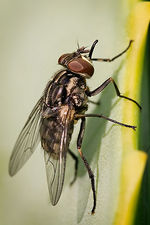Difference between revisions of "Stomoxys calcitrans"
Jump to navigation
Jump to search
| (18 intermediate revisions by 3 users not shown) | |||
| Line 1: | Line 1: | ||
| − | + | ==Introduction== | |
| − | + | ||
| − | + | [[Image:Stomoxys calcitrans.jpg|150px|thumb|right|'''Stomoxys calcitrans (Image sourced from Skoch3, Wikimedia Commons) ''']] | |
| − | + | ||
| − | + | {| cellpadding="10" cellspacing="0" border="1" | |
| − | + | | Also known as: | |
| − | + | | '''Stable fly | |
| − | + | |- | |
| − | + | |} | |
| − | + | ||
| − | + | *'''Visiting''' biting fly | |
| − | + | **Feeds on the host | |
| − | + | **Spends most of its time '''off''' the host e.g. In flight or resting on buildings, foliage and fences | |
| − | + | ||
| − | [[Image:Stomoxys calcitrans.jpg|150px|thumb|right|'''Stomoxys calcitrans''' | + | *Attacks most animals |
| − | Also known as: ''''' | ||
| − | + | *Found worldwide | |
| − | |||
| − | |||
==Identification== | ==Identification== | ||
| − | ''Stomoxys calcitrans'' has a high resemblance to [[Musca spp.|''Musca domestica'']]. | + | ''Stomoxys calcitrans'' has a high resemblance to [[Musca spp.|''Musca domestica'']]. ''S. calcitrans is 5-7mm long, and both the males and females suck blood. They are grey with four long longitudinal stripes on the thorax, and with large black spots on the abdomen. |
| − | ''S. calcitrans | ||
| − | The larvae are identified | + | The larvae are identified bu examination of the posterior spiracles. |
| − | Eggs | + | ==Life cycle== |
| + | *Eggs laid on rotting hay and straw | ||
| − | + | *Larvae feed on vegetable matter | |
| − | + | ||
| + | *Life cycle takes '''1 month''' | ||
| − | + | *Adult flies survive for 1 month | |
| − | |||
| − | + | ==Pathogenesis== | |
| − | + | *Production losses | |
| − | + | **Reduced weight gain | |
| + | **Milk yield losses | ||
| + | ***Up to 20% in cattle affected by '''fly worry''' | ||
| + | *Vectors for the retrovirus [[Equine Infectious Anemia|Equine infectious anaemia]] | ||
| − | + | *Mechanical vectors for protozoa e.g. trypanosomes in warmer countries | |
| − | + | *Intermediate hosts of the nematode [[Parasitic skin infections - Pathology#Helminths|''Habronema'']] | |
[[Category:Biting_Flies]] | [[Category:Biting_Flies]] | ||
| − | + | [[Category:To_Do_-_Max]] | |
| − | [[Category: | ||
Revision as of 17:38, 15 July 2010
Introduction
| Also known as: | Stable fly |
- Visiting biting fly
- Feeds on the host
- Spends most of its time off the host e.g. In flight or resting on buildings, foliage and fences
- Attacks most animals
- Found worldwide
Identification
Stomoxys calcitrans has a high resemblance to Musca domestica. S. calcitrans is 5-7mm long, and both the males and females suck blood. They are grey with four long longitudinal stripes on the thorax, and with large black spots on the abdomen.
The larvae are identified bu examination of the posterior spiracles.
Life cycle
- Eggs laid on rotting hay and straw
- Larvae feed on vegetable matter
- Life cycle takes 1 month
- Adult flies survive for 1 month
Pathogenesis
- Production losses
- Reduced weight gain
- Milk yield losses
- Up to 20% in cattle affected by fly worry
- Vectors for the retrovirus Equine infectious anaemia
- Mechanical vectors for protozoa e.g. trypanosomes in warmer countries
- Intermediate hosts of the nematode Habronema
